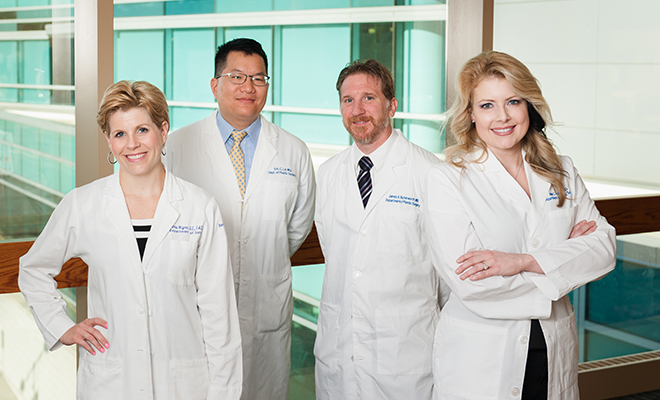 Lauren Frisch Pusateri
Lauren Frisch Pusateri
Spotlight on KU Microsurgery Experts
KU Microsurgery Experts:
Provide Effective Lymphedema Treatment and Support
written by cindy mcdermott | photographs by lauren frisch pusateri
Each year more than 200,000 cases of Lymphedema are reported in the United States. For some, it comes after treatment for breast cancer and causes painful and unsightly swelling that normally occurs in the arm. The most common cause of lymphedema is the removal of or damage to lymph nodes as part of the cancer treatment; this can be related to surgery or radiation therapy. When that occurs, a blockage in the lymph drainage system may prevent fluid from draining and the buildup leads to swelling.
Proactive Treatment
“If they have breast cancer and undergo a lymph node biopsy or removal, they certainly do run the risk of developing lymphedema in the upper extremities. Not only are women having to deal with treating their breast cancer, it can be compounded by experiencing lymphedema,” stated Dr. Julie Holding, MD, The University of Kansas Health System. “But treatments are available to help women with this condition.”
While there is currently no cure for lymphedema, it can best be managed through early diagnosis and treatment of the extremity at a multidisciplinary center such as the University of Kansas Health System, where lymphedema nurses and therapists work collaboratively with the breast oncology surgeons, Dr. Jamie Wagner, Dr. Amanda Amin and Dr. Christa Balanoff. The microsurgeons in the Department of Plastic Surgery, Dr. Holding, Dr. James Butterworth, Dr. Eric Lai and Dr. David Chandler, utilize the most up-to-date microsurgical techniques to treat lymphedema.
“The lymphatic system is a filter for the body and helps drain fluid through the body. If you have blocked nodes or channels, you will see swelling and you are at a higher risk of infection,” stated Dr. Holding. “When lymphedema occurs, the body has a natural response of building fibrous tissues and increased fatty deposits in the area that is blocked.”
Attentive and Supportive Care
For her patients, Dr. Holding will call upon her experience and knowledge to help them deal with lymphedema. She’s board certified in Plastic Surgery and received her fellowship training at the University of Washington. Based on effective communication and trust, Dr. Holding will strive to fully comprehend her patient’s needs and intended goals. She will provide information on a patient’s options for care, formulate an individualized treatment plan and be a source of support throughout the treatment process.
Managing lymphedema is critical to the overall health of an individual, and the lymphedema treatment team can call upon a range of options to help their patients. Depending on the individual, they might recommend a conservative treatment strategy. Conservative care can involve manipulation or massage of the affected area by a lymphedema nurse or physical therapist. This helps to mechanically move and drain the fluid from the body. The use of one or more layers of compression garments to control the fluid is another option.
New, Specialized Surgical Technique
For some cases, Dr. Holding or her colleagues might employ more aggressive treatment, which would call upon the use of microsurgery. “Microsurgical treatment for lymphedema is relatively new in the reconstructive world, but it is showing such promise,” noted Dr. Holding. “These microsurgery techniques are less invasive than the older excisional surgical treatment, and it allows us to more directly address the problem.”
Microsurgery lets surgeons perform delicate and minute procedures under magnification with highly specialized instruments. Dr. Holding could use Vascularized Lymph Node Transfers as a technique. Here, healthy lymph nodes are harvested from the groin and moved to the armpit. Using microsurgery, the surgeon reattaches the artery and vein of the lymph node to new blood vessels in the area.
Delicate Microsurgery
Another technique that Dr. Holding might employ would be Lymphaticovenous Anastomosis, which attempts to connect the affected lymphatic channels directly to the tiny veins located nearby. The lymphatics are minute, typically 0.1 mm to 0.8 mm in diameter, which is smaller than a pencil lead. The procedure requires the use of superfine surgical sutures and a high-power microscope.
“This is what we call super microsurgery. I would make small incisions to locate the lymphatics and bypass what is obstructing their flow,” she remarked. “Normally, this is done as an outpatient surgery, but at most it would mean an overnight stay in the hospital.”
Either one of these techniques can be an effective and long-term solution for extremity lymphedema. Many patients experience a moderate to significant improvement in their symptoms.
“My work is to improve the quality of life for my patients,” Dr. Holding noted. “While severe infection can result from lymphedema, the vast majority of sufferers really need to be able to enjoy life and not allow it to negatively impact their participation in daily activities. There is an answer and there is hope.” HLM
For more information, call 913-588-1227 or 913-588-2000.









